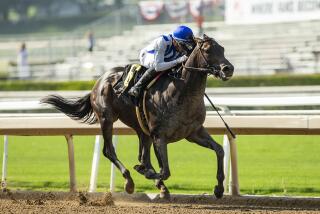Jockey Calls His Tumble a Wake-Up Call : Racing: Richard Migliore’s near-fatal spill came in 1988 when three horses in front of him went down. He was told he would probably be quadriplegic. But he recovered to ride again.
NEW YORK — When he was a kid, Brooklyn-born Richard Migliore’s family moved to Long Island and he started riding show horses. “The head instructor thought I might be an Olympic rider, but all I wanted to do was watch the races on Saturday,” he said.
At 14, he lied about his age and “lived in subhuman conditions and rode anything with four legs for $150 a week.”
By 16, he was New York State’s leading apprentice jockey, never thinking about the danger. “At that age you think it will never happen to you,” he said.
Migliore’s first tumble came on a sloppy track when his horse hooked legs with another horse. “It’s like having the rug pulled out from under you. We both went end over end, and as spectacular a spill as it was, I was only very bruised and battered. It certainly left an impression.”
Migliore’s near-fatal spill came on Memorial Day, 1988, at Belmont Park, when three horses in front of him went down. His mount instinctively tried to jump over as the downed thoroughbreds struggled to their feet.
“The last thing I remember is hitting the pate, the hardest part of the horse’s head. I woke up as the ambulance was pulling into the hospital.”
The doctors told him he would probably be a quadriplegic and certainly never ride again. He says paralysis is the worst fear of all jockeys.
“They would rather be killed than paralyzed.”
Four months later, he was hobbling from his house to the backstretch to watch through a fence as the horses worked out. Six months later, he was riding. He brought his first mount home a winner.
“You have your share of tumbles but nothing can ever prepare you for the shock of a racing spill. There’s no way you can understand it. Suddenly it’s like an explosion and everything breaks loose. You hit the ground harder than you ever hit the ground in your life.
“It did my career a service,” he said of the near-fatal spill. “It was a wake-up call. I needed to get jolted back to reality--’Hey, dummy, you got the greatest thing going here, so you’d better respect it and appreciate it.’ ”
He accepts the fear.
“It’s like you say one of these days that you’re going to crash in your car, but you keep on driving.”
Mike Venezia, who was killed at 44 in a spill at Belmont in 1988, was a mentor to him. So was Eddie Maple. Migliore, who plans on retiring to train at 35 or so, also tries to return the help he got.
“When the young kids coming up look at the scars on my body, some of them will ask about them,” Migliore said. “Others won’t. They don’t want to know.”
More to Read
Go beyond the scoreboard
Get the latest on L.A.'s teams in the daily Sports Report newsletter.
You may occasionally receive promotional content from the Los Angeles Times.










